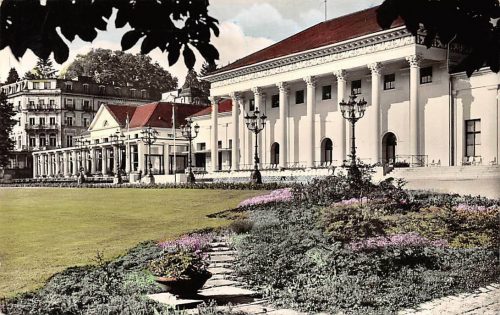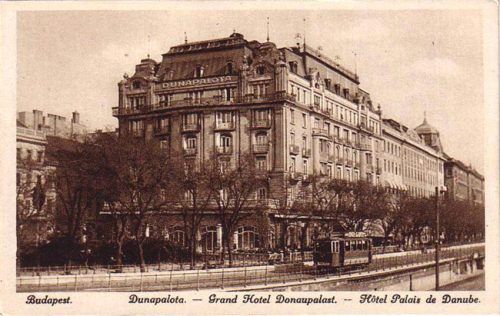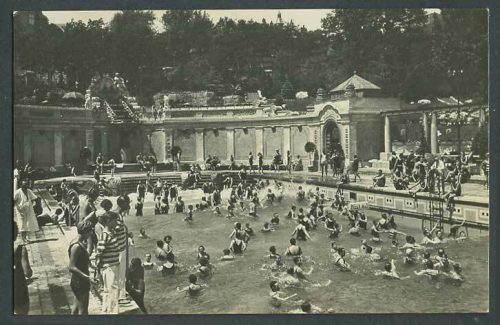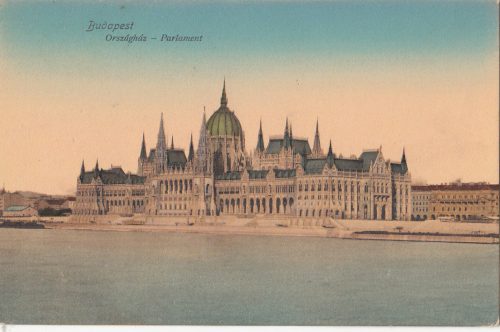Travels with Grace: Budapest
Welcome to this week’s segment of our 2019 #TravelTuesday series: Traveling with Grace. Today Grace heads to Budapest during the summer of 1929.
August 11, 1929

Germany Baden-Baden Das Kurhaus, Echte Photo, AK. Via.
Sunday, Vienna. We take the electric train for Baden this morning, a ride of a little over an hour. Our pleasure is rather marred by the rain. The Kurhaus gardens are very pretty interspersed with flowers, wooded glades, monuments, covering the mountain side. Perched on high is a round observatory overlooking the countryside. In the Kurhaus is a fine marble salon with a huge fountain whence the surplus water is dispensed. Tonight, colored lights play on a large fountain in the square near our hotel.
August 12, 1929
Left Vienna at 11:05 a.m. On way pass the beautiful town palace of the Rothschilds. Otto Kahn of New York also has a fine residence here which he occupies (according to Dame Gossip) when Jeritza is in town. The trip to Buda-Pest takes five hours and it is very hot. When nearing it we come in sight of the Danube where geese and horses are bathing with the people.
August 13, 1929

Hotel Dunapalota, 1918. Via.
We are located at the hotel Duna Palota one of the nicest thus far encountered. In the evenings there is a gypsy orchestra playing in the garden where we dine and the music is lovely. This morning we go out with a lady guide and ride around Buda, the newer and higher town on the west side of the river. We see the Petrofi monument, many beautiful museums, the fine Central Market Hall where the most abundant and varied produce is for sale. Hungary was formerly almost exclusively agricultural but now they are developing many industries. Here as in Vienna they are very bitter about Wilson’s 14 points and the Trianon treaty and feel that they have been raped. While Austria’s population has been reduced from 56 million to 6 million, Hungary’s has been reduced from 20 odd million to 7 odd.

Hungary Budapest Hotel St. Gellert Artificial Wave Thermal Bath Old RP Postcard. Via.
We next visit the Gellert’s mineral baths adjoining a fine hotel. In the huge swimming pool lined with blue tiles artificial waves are produced by an electric device. A beautiful bronze statue of St. Gelleret upholding a cross stands up on the hill where he suffered martyrdom 1000 years ago for introducing Christianity into the country. We enter the new section of the royal castle (27 years old) and visit a number of the rooms: the walls are mostly marble lined, each room different in color and pattern, the floors beautifully inlaid, the chandeliers of carved wood gilden and in the state ball room they are solid silver and crystal. In the smaller rooms the walls are covered with the same velvet brocade which upholsters the furniture and forms the window draperies. There are many interesting portraits of the royal family and the many ancestral castles, also some handsome tapestries and large pieces of Sevres and Meissen. But it is not overcrowded. The exterior is very imposing. On one side is a fine group of bronze statues with animals of the chase in most life-like attitudes, King Mathias dominating the group. On the other side is a broad staircase descending in terraces to a garden below in the center of which is a statue of Eugene of Savoy on horseback. From the top is a fine view across the Danube. Then we ride up to the Coronation Church surrounded by a group of very imposing structures including the Holy Trinity Monument and Fisher’s Ramparts through the openings of which is framed the lovely Gothic Parliament Building opposite in Pesth. Then we cross one of the large suspension bridges (there are four or five) which spans the river in a single span said to be copied from the Brooklyn Bridge.

Hungarian parliament building. Via.
This afternoon we see the beautiful monument to Vörösmarty who wrote the national hymn. He is surrounded by expressive figures representing all classes of the people. Also monuments to Frances Deale and Stephen Szechnyi. Then we go into the huge Parliament Buildings, handsome as a palace. The staircase is most magnificent. All colors of marble are used in its construction (it took 17 years to build) and there are lovely windows with coats-of-arms and national heroes done in panels of stained glass. Also, huge oil paintings of legendary subjects, battle and other historic scenes. We enter the chamber of the Lords and of commons, the reading and lunchrooms, the large round room where the Regent convenes the new Parliament when both houses meet together. The decorations are very fine. The place of the assassinated Count Tissa has remained empty since his death, the seat having been taken out as a memorial. Also, in the square monuments have been erected to the lost provinces and the flag remains always at half-mast as a sign of mourning.
We ride through the lovely park on St. Margaret’s island where there is a fine swimming pool with a capacity for 40,000 people. There is a natural hot sulphur spring in the park which has been known to flow for thousands of years and fine bathing establishments, restaurants, a hotel, tennis courts where one can play in bathing suits, a polo field, etc. I notice in the city the women of the lower classes wear no hats, but a kerchief tied around their heads. We see one fine synagogue.
August 14, 1929
Start out with guide this morning. See court of justice and beautiful memorial group of Kossut and his ministers. We ride along several fine residential avenues (see home of Vanderbilt, Czechnyis), and enter the beautiful city park, at the portal of which is a semicircular marble colonnade with colossal figures of all of the rulers of Hungary in bronze and below each a tablet in bas relief describing some events in their reigns. Before this is the grave of the unknown soldier and a cavalry officer always stands at salute on guard. On either side of the entrance to the park stands a fine museum, one of which houses the art collection. Just within the gates is an artificial lake used for boating in summer and in winter ice machines keep it always ready for ice skating. Beside the lake are erected a most picturesque group of buildings modeled after famous old Hungarian castles in different parts of the kingdom. One of these houses the agricultural museum. The park contains a number of other fine buildings used for exhibition purposes, some pretty statues, one of George Washington erected by Hungarian-Americans, botanical gardens and a zoo modeled after Hagenbecks in Hamburg. There is also a large medicinal bathing establishment.
This afternoon we visit a factory where lovely Hungarian jewelry is made, also silverware, all copied from antiques. Also see some of the very colorful Hungarian embroideries. Then take a lovely ride up to St. John’s Hill to enjoy the fine panoramas of Buda-Pesth and the Danube. Visit St. Stephen’s church, a large modern structure. On St. John’s Hill is a large observations tower, memorial to Queen Elizabeth beloved by the Hungarian people, who used to frequent this spot.
August 15, 1929

Waterfall on Margaret’s Island, 1928. Via.
Spend this afternoon on Margaret’s Island which is crowded, this being a holiday. It is quite a sight watching the bathers on the strand. We see a number of peasant women barefooted, kerchiefs on head, purple dresses with voluminous skirts under which show dozens of red petticoats like old fashioned ballet dancers. Tonight, we have dinner at a nice Jewish restaurant – Neiger’s – afterwards go to a large café where there is a good Gypsy band and then we go to a fine cabaret – Jardin de Paris – where there are a variety of excellent numbers until 1:30 a.m. The people are much in evidence on the streets and in the park at this hour of the morning. Mr. Weiss escorts us.
August 16, 1929
Spend part of the day in zoological gardens and tonight go up on the roof garden of the hotel, of which they are quite proud as they consider it so up-to-date and Americanized – they call this hotel the Waldorf-Astoria of Budapest – and from here we have a wonderful view of the city which is very brightly illuminated. In Buda, across the river, the old citadel at one end and Fischer’s ramparts at the other, stand out brilliantly lighted by a system of concealed lamps which have the same effect as a searchlight. A jazz orchestra plays and sings.
August 17, 1929
Saturday, Budapest. Sat in one of the parks with which the city is generously sprinkled. A band plays and it is interesting to watch the people, especially the peasants in their colorful and numerous skirts, who use it as a thoroughfare. A woman comes around with a basket of mammoth pretzels. Tonight Mr. Weiss takes dinner with us after which we take a ride on the island where the hundreds of lights from the many restaurants make it look like a veritable fairy-land. We go to another cabaret in another part of the city near the zoo. There is a good trained dog act in which one dog walks a tightrope. The natives eat plenty of bread and drink quantities of beer. Vendors of flowers and cheap souvenirs abound.
Thanks for reading “Traveling with Grace,” a series where we’re sharing (and annotating) posts from the travel diaries of Grace Amelia Hecht, native Baltimorean, b. 1897 and d. 1955. As mentioned in my introductory post transcription errors sometimes occur and I’ve made my best guesses where possible, denoted by [brackets]. – Rachel Kassman, marketing manager
